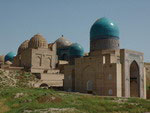 |
| source: awd.ru |
Not far from the grand mosque of Bibi Khanum there stretched one of the most mysterious and unique monuments of Samarkand - Shah-i-Zinda necropolis. The uniqueness of this set of tombs and mausoleums associated with high levels of ceramic and architectural art. Also, have survived eleven mausoleums built in the chain between XIV-XV centuries, and during the excavations the remains of tombs XI-XII centuries were found. Given the study of the cultural layer in the complex can be argued that in the Shah-i-Zinda necropolis impact 2500 years history of Samarkand.
The name of the entire ensemble is associated with the same crypt Shah-i-Zinda, where there are buried close relatives of Tamerlane, and there is the mausoleum of Kusama ibn Abbas, a cousin of the prophet Mohammed, which is connected with the legend that gave the name of the entire complex.
According to legend, Kusam ibn Abbas went with a small army to march on Samarkand, to adopt Islam as religion. During one battle he was wounded by an arrow, but managed to escape from enemies in the crevice (wells), where he lives to this day. Shah-i-Zinda - translated from Persian as "living king”.
The complex begins with the entrance portal, which is the new construction. Behind it there are three groups of mausoleums: lower level belongs to the era of Ulugbek, the average is associated with the rule of Tamerlane, and the upper consists of ancient buildings. Between these two groups of buildings there are arch-domed passages - Chartaks.
It affected the development of architectural thought of monumental and decorative art of the East. In 2001, Shah-i-Zinda necropolis was included in the UNESCO World Heritage List.

